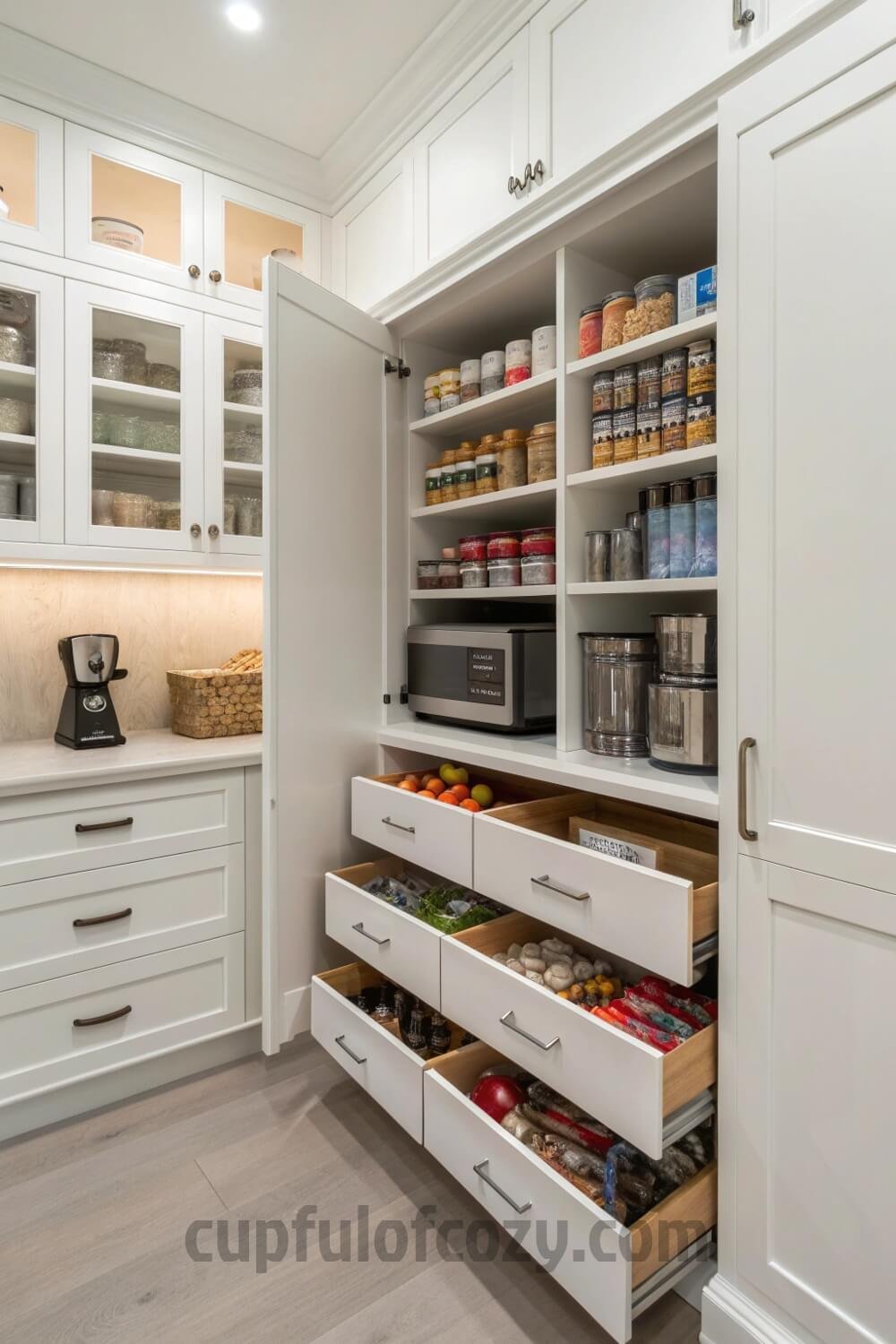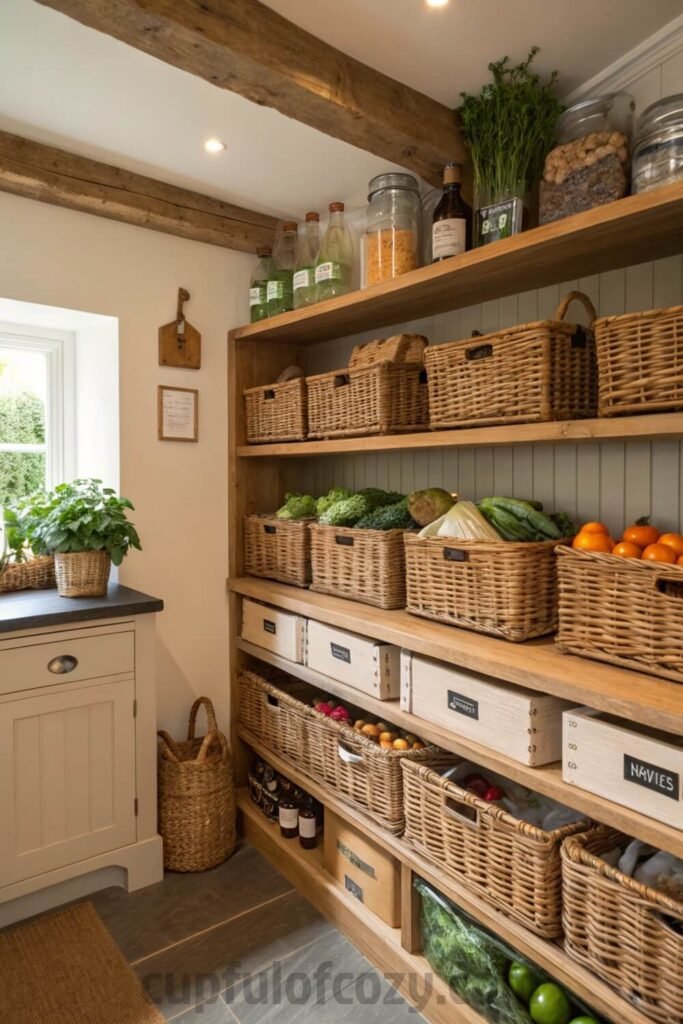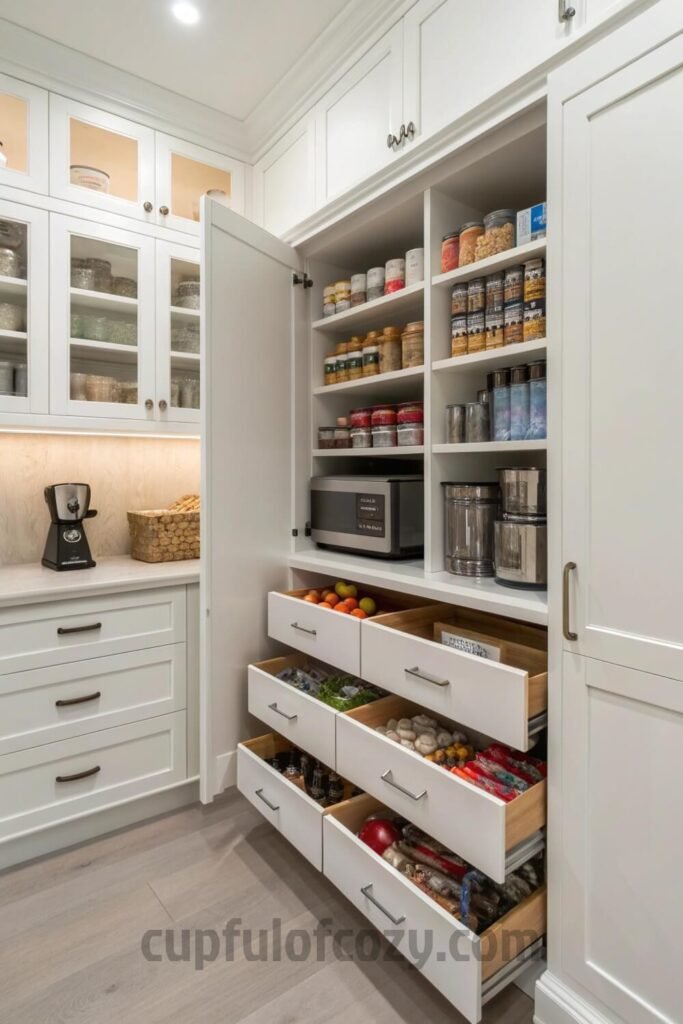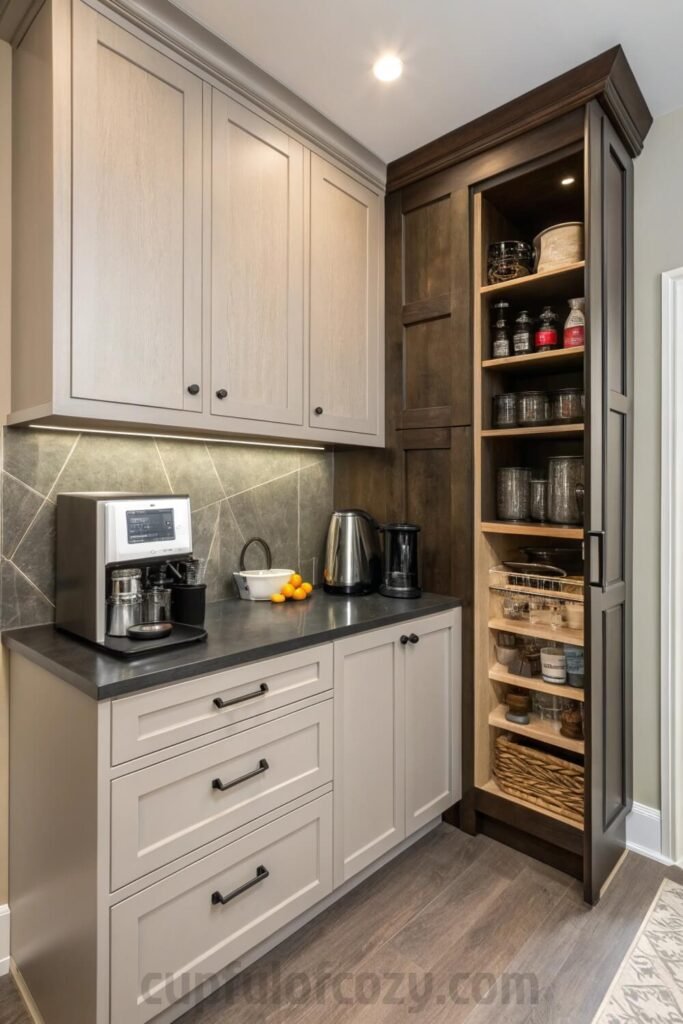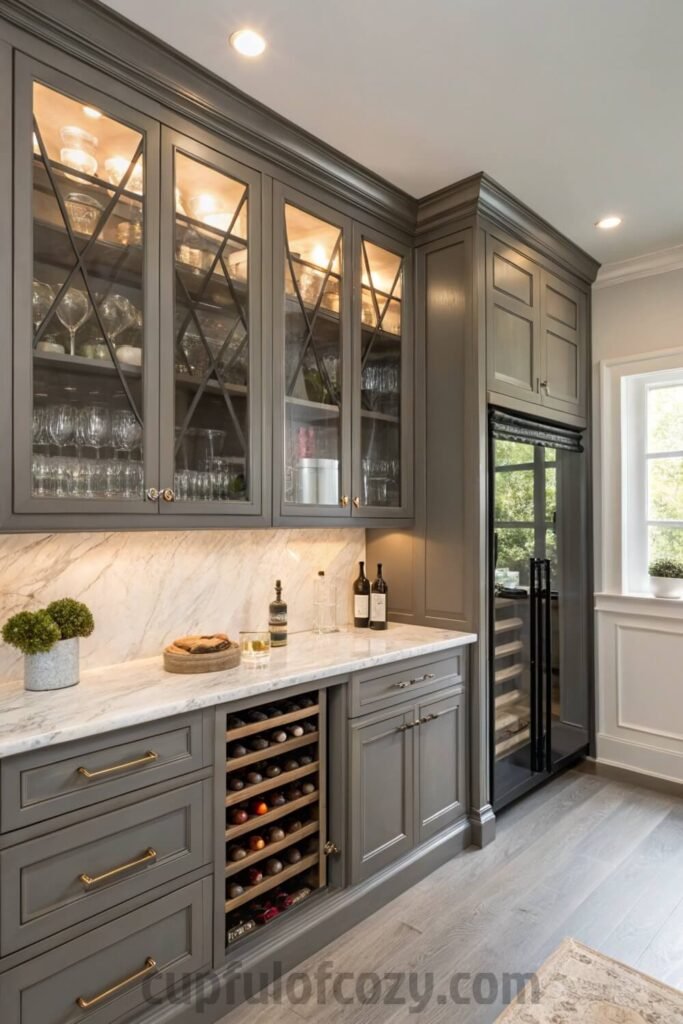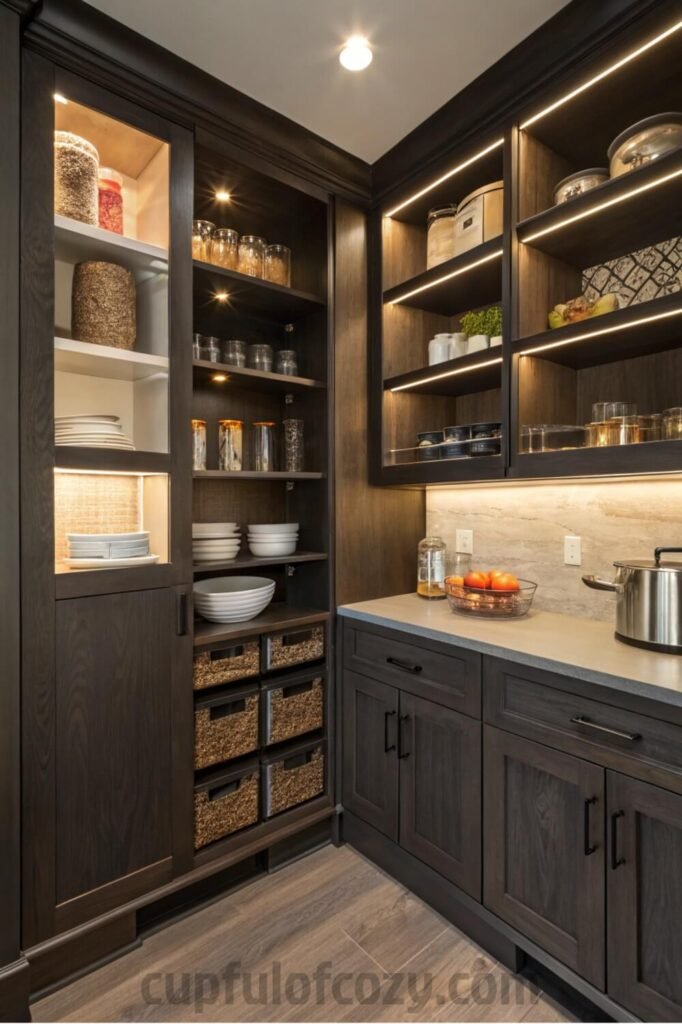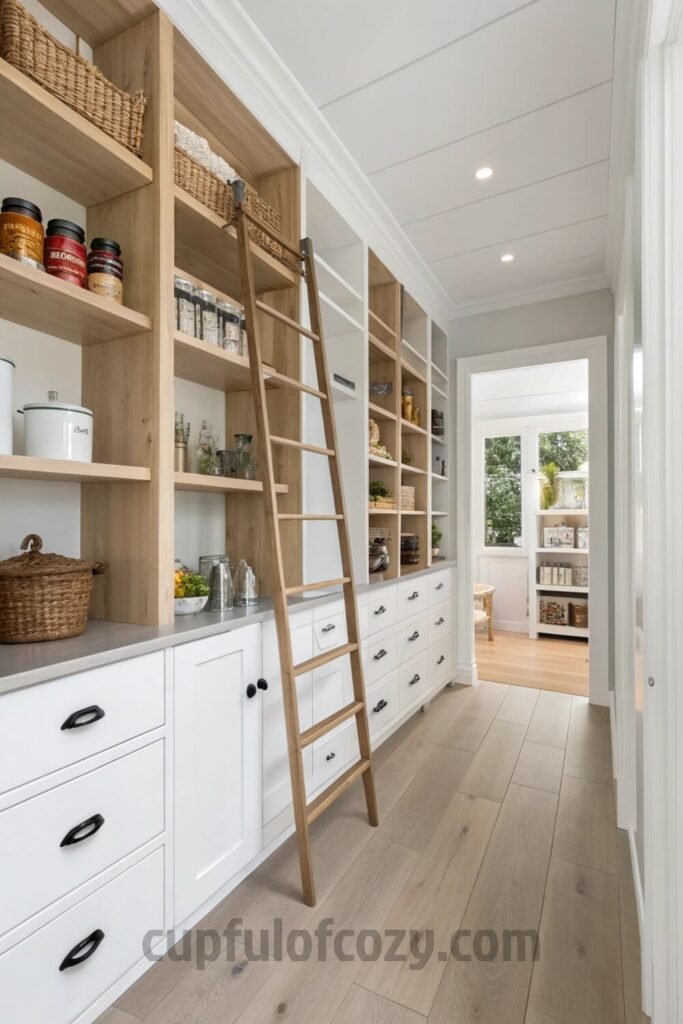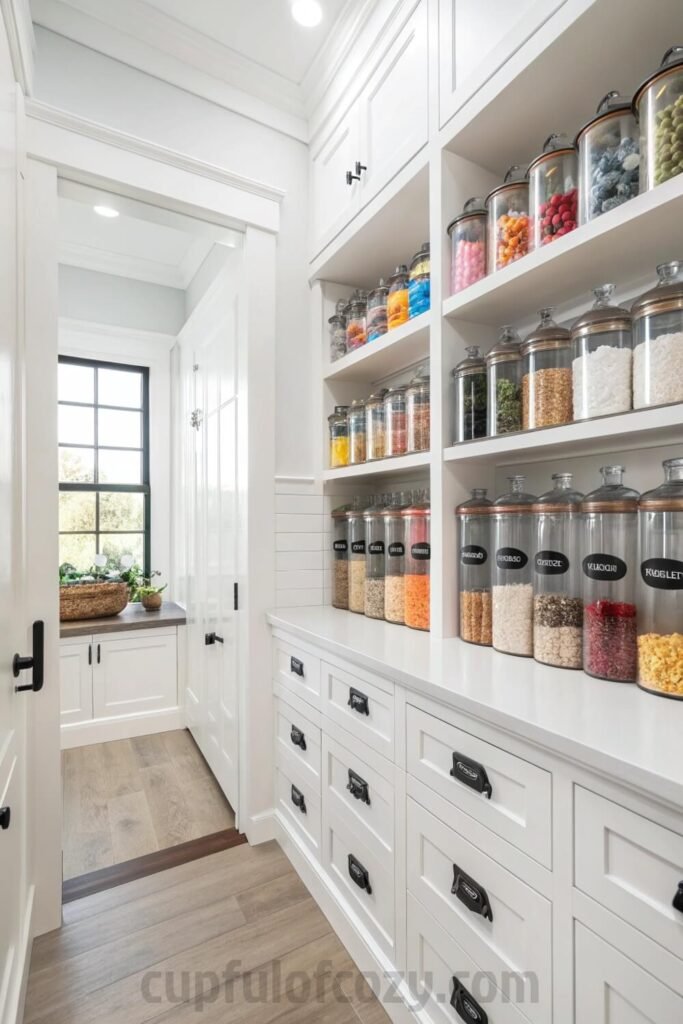I’m deep in this rabbit hole of gorgeous pantry organization. You know how it goes: one minute you’re looking at dinner recipes, next thing you know you’re questioning every storage decision you’ve ever made.
Here’s what really gets me though – I grew up in this tiny house where our “pantry” was basically two cabinets that my mom somehow made work for a family of five. She had this system where everything had its exact place, and God help you if you put the peanut butter where the jam was supposed to go. I used to think she was being dramatic, but now I get it. When you’re working with limited space, every inch matters, and chaos spreads faster than gossip in a small town.
Fast forward to now, and I’m living in this place with an actual butler’s pantry. It’s not huge – honestly, it’s more like a really wide hallway with shelves – but when I first saw it, I felt like I’d won the housing lottery. Then reality hit. Having the space and knowing what to do with it are two completely different things. I spent the first three months just shoving stuff in there and hoping for the best, which basically turned it into an expensive closet where cereal boxes went to die.
The turning point came when my friend Sarah visited and gently (okay, not so gently) roasted my pantry situation. She opened the door, surveyed the chaos, and said, “Girl, this looks like a grocery store after a tornado.” Harsh but fair. That weekend became my pantry intervention, and I went down this incredible research spiral about small-space storage solutions.
What I discovered changed everything. These aren’t just organization tips – they’re like life hacks that make your kitchen actually work for you instead of against you. I’m talking about solutions that turn dead space into storage gold, systems that make grocery shopping feel less like a puzzle, and setups that actually save you money because you stop buying duplicates of stuff you already own but can’t find.
My mom always said, “A place for everything and everything in its place,” but she never told me how to figure out what those places should be. Turns out, it’s not about having the perfect pantry – it’s about making your pantry perfect for how you actually live. Some of us are bulk buyers, others are minimalists. Some families go through snacks like they’re preparing for the apocalypse, others barely touch processed food. Your storage should match your reality, not some Instagram fantasy.
The best part? Most of these ideas don’t require a complete renovation or breaking the bank. I’ve tried almost all of them (some more successfully than others), and I’m excited to share what actually works in real life, not just in pretty photos. We’re talking about solutions that make sense when you’re rushing to pack school lunches, hosting unexpected dinner guests, or just trying to find the vanilla extract without having to excavate half your pantry.
So if you’re staring at your butler’s pantry wondering how to make it work harder for you, or if you’re like me and inherited this space but had no clue what to do with it, these nine ideas are going to change your whole kitchen game. Some of them might seem obvious once you see them, but isn’t that how the best solutions usually are?
1. Adjustable Shelving: Your New Best Friend
My biggest pantry revelation came from the most boring thing possible: shelf brackets. I know, I know – not exactly thrilling. But hear me out, because this completely transformed how I think about storage.
Fixed shelves are basically the enemy of functional pantries. They’re like trying to wear a one-size-fits-all shirt – technically it fits, but it’s never quite right. I had these predetermined shelf heights that made zero sense for what I actually needed to store. Giant cereal boxes wouldn’t fit standing up, so they’d lay sideways and waste space. Tiny spice jars would sit on these massive shelves with acres of unused vertical space above them.
Adjustable shelving lets you customize the height for whatever you’re storing, which sounds simple but feels revolutionary when you experience it. Now I can have tight spacing for short items and generous height for tall stuff. When I buy those family-size everything containers from Costco, I just move the shelf up. When I’m in a small-jar phase, I move it down.
The flexibility means your pantry evolves with your needs instead of fighting against them. Last month I was on this homemade bread kick (thanks, weekend cooking shows), so I adjusted one shelf to perfectly fit my bread pans and mixing bowls. This month I’m back to regular grocery store bread, so that space is now optimized for snack storage. It’s like having a pantry that actually pays attention to your life changes.
2. Basket Storage: Pretty Meets Practical
There’s something so satisfying about baskets that I can’t quite explain. Maybe it’s because they make even the most random collection of stuff look intentional, or maybe I just have a thing for woven textures. Either way, baskets saved my pantry from looking like a grocery store explosion.
Clear labeled baskets became my solution for all those items that never seemed to have a proper home. Loose potatoes that used to roll around like they were planning an escape? Now they live peacefully in a basket. Random snacks that my kids grab for school? Contained. Onions and garlic that used to hide in corners until they sprouted? Organized and visible.
What I love most is that baskets make everything accessible. Instead of digging through a pile of loose items, you can pull out the whole basket, grab what you need, and put it back. My friend Lisa came over last week and watched me pull out the “movie night snacks” basket, and she literally said, “Okay, that’s genius. I’m stealing this idea.”
The handles are crucial though. Get baskets with sturdy handles that won’t break when you’re pulling them out full of canned goods. I learned this the hard way when my first handle snapped and I had soup cans rolling all over my kitchen floor. Not my finest organizational moment.
3. Pull-Out Drawers: Because Life’s Too Short for Cabinet Diving
Remember being little and watching your mom practically disappear into the back of deep cabinets, emerging with some mysterious ingredient like she’d been spelunking? I swore I’d never do that as an adult, yet here I was, crawling into my pantry cabinets like I was exploring caves.
Pull-out drawers changed everything. Suddenly, every item in my pantry had equal access to daylight. Canned goods that used to hide in the back now slide right out front. Small appliances that I’d forgotten I owned became part of my regular rotation again. Those weird condiments I bought for one specific recipe? They’re right there, reminding me to actually use them.
The smooth-gliding part is important – cheap slides that stick or require wrestling aren’t worth it. I invested in good quality hardware, and now pulling out a drawer feels effortless even when it’s fully loaded. It’s one of those upgrades that seems small but makes such a difference in daily life.
My cousin installed these throughout her tiny pantry, and she jokes that grocery shopping became fun again. She knows exactly what she has and where everything goes, so no more buying duplicate items because something was hiding in the cabinet depths.
4. Appliance Garage: Give Your Gadgets a Home
Coffee makers on counters stress me out. There, I said it. They’re bulky, they have cords everywhere, and they make even the cleanest kitchen look cluttered. But I also need my coffee maker to be immediately accessible every morning because pre-coffee me is not someone you want to challenge with complicated appliance logistics.
An appliance garage solved this perfectly. It’s basically a designated parking spot for small appliances – somewhere they can live that’s accessible but not taking up visual space. I dedicated a specific cabinet section for my coffee maker, and now my mornings are smooth and my counters stay clear.
The setup needs to make sense for how you actually use things though. My coffee maker lives in a pull-out cabinet right next to my mugs, with easy access to a power outlet. I don’t have to move anything or set anything up – I just slide out the drawer, press the button, and coffee happens.
I also have spots for my blender (which I actually use now that I can see it) and that fancy juicer I bought during my health kick phase. Even though the juicing enthusiasm didn’t last, at least the juicer isn’t cluttering up my counter space while it waits for me to remember I own it.
5. Specialized Storage: Making Weird Spaces Work
Every pantry has those awkward spaces that seem designed to mock your organizational efforts. You know the ones – weird narrow gaps, odd corners, spaces that are too small for normal shelves but too big to ignore. I used to look at these areas and just accept that some space would be wasted.
Specialized storage turned those problem areas into solutions. Vertical slots for cutting boards and serving trays transformed a skinny space next to my pantry door into perfect storage for flat items that used to take up entire shelves lying down. Now they stand up like little soldiers ready for action.
Wine racks work the same way for weird corner spaces, and honestly, even if you’re not storing wine, those same slots are perfect for storing bottles of cooking oils, vinegars, or those tall skinny items that never seem to fit anywhere properly.
I saw this approach at my friend Emma’s housewarming party, where she had custom vertical slots built right into her pantry. She was storing everything from baking sheets to reusable shopping bags in spaces I would have never thought to use. It made me look at my own pantry completely differently.
6. Corner Solutions: Lazy Susans for the Win
Corners in pantries are basically where items go to disappear forever. It’s like the Bermuda Triangle of kitchen storage – you put something back there and it might as well have been launched into space. I used to have this corner cabinet where condiments went to die slow, forgotten deaths.
Lazy Susans completely solved this problem, and using them feels oddly satisfying every single time. There’s something so pleasing about spinning that platform and watching all your items rotate into view like you’re operating some kind of pantry carousel. No more blindly reaching into dark corners hoping you’ll grab the right sauce.
The spinning action brings everything to you instead of making you excavate the depths of your storage. My hot sauce collection (which may be slightly excessive) now lives on a lazy Susan, and I actually use different varieties because I can see what I have. Before, I’d just grab whatever was in front and ignore the rest.
Moving corner shelves work the same principle for larger items. Instead of static storage that inevitably becomes a black hole, you get rotating access to everything. It’s like giving your pantry storage a little dance move that makes everything reachable.
7. Going Vertical: Use Every Inch
High ceilings in pantries are basically unused real estate that most people ignore. I was guilty of this too – looking at all that empty air space above my regular shelves and just accepting that it was decorative. Then I realized I was sitting on storage gold.
Floor-to-ceiling shelves or upper cabinets turn that wasted vertical space into prime storage territory. Yes, you need a step stool or sliding ladder for the top shelves, but that’s perfect for items you don’t need daily access to. Seasonal baking supplies, bulk purchases, holiday serving dishes, all those things that are important but not everyday essentials.
The strategy is keeping frequently used items at eye level and letting the high shelves handle overflow and occasional-use items. It’s like having a storage hierarchy that makes sense with how you actually live.
My grandmother had this approach in her old farmhouse kitchen. She had this wooden step stool that lived in her pantry, and watching her climb up to retrieve some special ingredient for holiday baking felt like watching a magician at work. She used every single inch of that space efficiently, and nothing ever went to waste because she knew exactly where everything lived.
8. Clear Containers: See It, Use It
This transformation took my pantry from chaotic to magazine-worthy, but more importantly, it changed how I cook and shop. Transferring dry goods, spices, and snacks into clear, airtight containers with labels made everything visible and accessible in a way that changed my whole kitchen routine.
No more mystery ingredients hiding in their original packaging. No more buying flour when I already have three bags tucked away somewhere. No more wondering if those crackers are still fresh or if that spice is still potent. Everything is visible, everything stays fresh, and everything has its designated home.
The labeling part is crucial though. Three months after organizing, you won’t remember if that white powder is flour, powdered sugar, or baking soda. I learned this lesson the hard way during what was supposed to be a simple cookie baking session but turned into a chemistry experiment gone wrong.
There’s also something deeply satisfying about opening your pantry and seeing rows of matching containers lined up like a well-organized library. It makes cooking feel more intentional and less chaotic, like you’re working in a real kitchen instead of just grabbing random ingredients and hoping for the best.
9. Smart Features: Welcome to the Future
Automated lighting that turns on when you open the pantry door sounds fancy, but it’s actually incredibly practical. No more fumbling around in the dark trying to identify mysterious jars, no more using your phone flashlight to find late-night snacks. The lights just come on, and suddenly your pantry feels like a well-designed retail space.
Temperature control panels keep items at optimal storage conditions, which is especially helpful if your pantry gets warm or humid. Some foods are pickier about their environment than others, and maintaining consistent conditions means everything lasts longer and tastes better.
A charging station might seem excessive, but think about how often you’re in your kitchen with your phone or tablet. Recipe lookup, grocery list updates, music streaming while you cook – having a dedicated charging spot right in your pantry keeps your devices powered and accessible without cluttering up your main counter space.
I experienced this setup at my friend Rachel’s new house, and I was genuinely impressed by how thoughtful it felt. Her little charging station meant she could keep her tablet right there for recipe reference while she was checking what ingredients she had on hand. The whole system felt integrated and purposeful instead of just thrown together.
These features turn your pantry into more than just storage – they make it a functional hub that actually supports how you cook and manage your kitchen. It’s like upgrading from basic transportation to a car with all the convenience features that make every trip more pleasant.
Final Thoughts
Here’s what I’ve learned from trying most of these ideas: you don’t need to implement everything at once. Start with whatever problem bugs you most. Maybe you’re dealing with corner chaos and that lazy Susan is calling your name. Maybe you’re drowning in small appliances and need that garage situation figured out.
The goal isn’t creating Instagram-perfect storage – it’s making your pantry work better for your actual life. A functional pantry that makes sense for your cooking style, shopping habits, and daily routine will make everything easier. And honestly, there’s something wonderful about opening your pantry and knowing exactly where everything is and that it’s all working together instead of against you.
- Before buying anything online, check Rakuten (formerly Ebates) — either with the browser extension or directly on Rakuten.com. Just type in your store, click the current deal, and shop as usual. Every purchase earns you cashback that can be mailed to you or sent via PayPal. In today’s economy, even a few dollars back can turn into a Starbucks latte, McDonald’s fries for the kids, or a little treat you don’t have to budget for. If you’ve never used Rakuten before, you’re missing out on free money — and right now, you’ll even get a $30 bonus when you spend your first $30. Click here to sign up and stop letting your online orders steal from you. Click here to sign up and save money!
*Disclosure: This post includes affiliate links. I may earn a small commission if you join Rakuten through my link — but it doesn’t cost you anything extra. In fact, you’ll actually save more!

